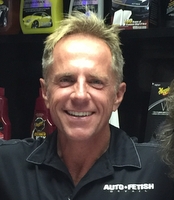Clear Coat Scratch Remover:
One kit, many options
Life is a jungle, and most cars owners will eventually search for clear coat scratch remover due to this thing called "life".
The problem is that most cars owners don't understand the basics of clear coat, let alone attempting to fix a scratch in their car clear coat.
One thing I know for certain - you will be overwhelmed by the opinions!
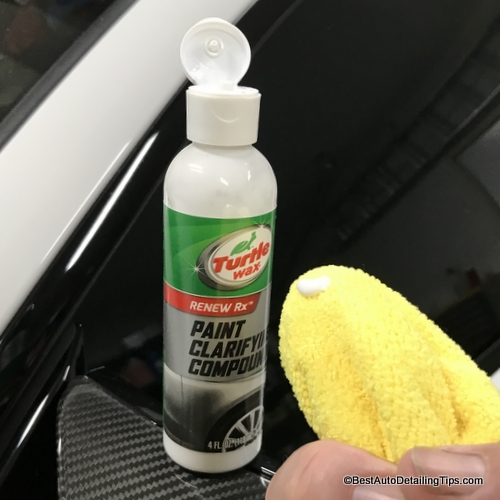
Without a basic understanding of what clear coat is, what it does, and how to identify the types of clear coat scratches will only make shopping for a clear coat scratch remover that much more confusing and frustrating.
Clear Coat Scratch Remover:
What you need to know
Before we go in for a deeper dive into clear coat and the task of trying to remove scratches in clear coat, there are some very basic nuggets of knowledge you should know as a car owner:
"The only way to permanently remove or diminish a clear coat scratch will be through the use of some type of abrasive product"
I will emphasize "remove or diminish" in this moment as this is a distinction from camouflaging or concealing a clear coat scratch.
And as you can begin to see, this topic can easily and quickly become more complex than you likely would have imagined.
- Difference between clear coat scratch and scratches
- Best clear coat scratch removal kit
- Permanent scratch removal vs. scratch concealment
- Clear coat vs. car paint
- What is clear coat
- What does clear coat do
- What you need to know about clear coat
Clear Coat Scratch vs. Clear Coat Scratches
Most people would not call this a difference. One seems singular, and one seems plural.
The distinction I want to make is that many people will look at the overall appearance of their car and see that it looks as thought there are thousands upon thousands of scratches that make up the entire surface of their car paint.
This is the distinction.
What I just described is what I call the overall appearance of your car's paint, which is different than identifying a distinguishable, isolated scratch on your car paint (or clear coat which are one in the same)
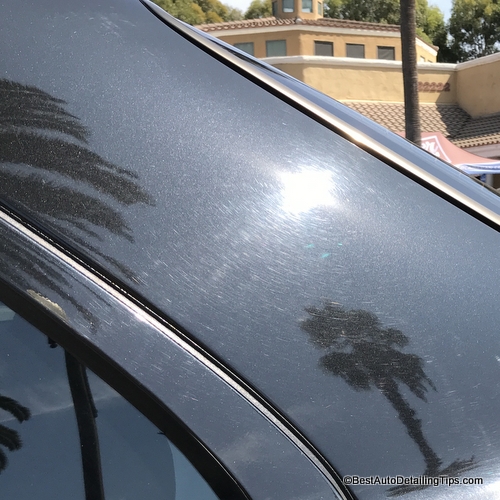 This picture illustrates what is often referred to as cob-webbing, spider-webbing, or swirl marks in car paint. This also perfectly illustrates an overall appearance to car paint that is different from a distinguishable, single scratch
This picture illustrates what is often referred to as cob-webbing, spider-webbing, or swirl marks in car paint. This also perfectly illustrates an overall appearance to car paint that is different from a distinguishable, single scratchThis picture above shows what most car paint looks like as an overall appearance - the surface appears as though there are countless micro-scratches that make up the entire surface of your car.
This is normal, and this is different than an isolated or distinguishable scratch in your car's clear coat.
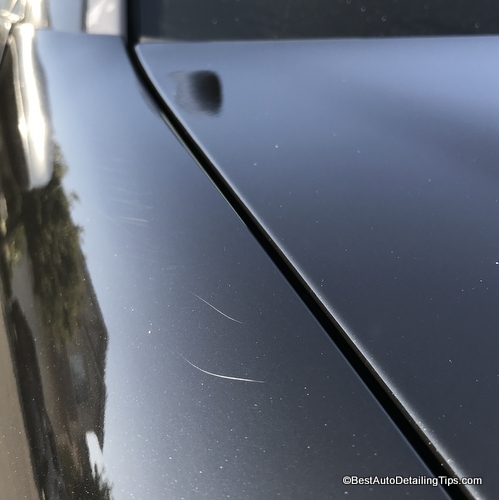
The picture above shows the distinction between specific clear coat scratches that can be identified as unique and specific, from an overall "scratched" appearance to car paint.
There are specific ways to deal with both types of car paint problems.
Just know that both these type of problems are normal for any car owner. The problems simply vary in severity from one car to another, or from one scratch to another.
Best Clear Coat Scratch Remover Kit
As much as I dislike the use of "best", I am labeling the following clear coat scratch removal kit as my pick as the best.
And when I say best, I am referring to any car owner looking to deal with the specific, isolated deeper scratches you will eventually come across.
If you have come here looking for a way to fix or improve what I refer to as an overall appearance of your car's paint, then you can see my car polishing for beginners.
Turtle Wax T-234KT Premium Grade Scratch Repair Kit
- Comprehensive kit includes products for multiple strategies
- My "go-to" kit for clear coat scratch removal
- Kit includes products ranging from mild to wild
Darren's Note: This kit not only gets my vote, but is a very popular clear coat scratch repair kit on Amazon. Except for a few negative reviews that come from people I consider too inexperienced to know better, or simply have unrealistic expectations.
This kit represents the perfect Do-it-yourself repair kit for many of the "uninvited" things clear coat or car paint related.
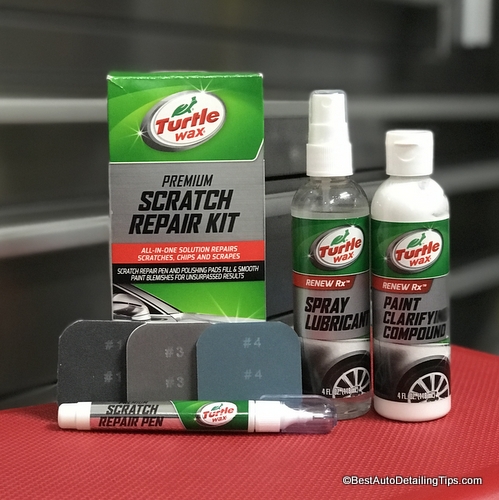
Paint Clarifying Compound: This one product can replace many of the dedicated car paint scratch removers sold individually on the market.
It is also what I refer to as my "first responder" when it comes to a clear coat scratch remover as it is a "compound" that has actual abrasives that allow you one of three possibilities:
- Will completely remove very shallow and superficial clear coat scratches
- Will diminish a clear coat scratch
- Will do nothing to the clear coat scratch
Every clear coat scratch will truly be unique in character. Some scratches will be hairline scratches, some can be deep gouges, and then some will fall somewhere within that spectrum.
Not only will each clear coat scratch prove unique, but the length of the scratch itself will vary from one end of the scratch to the other end.
What this will mean to you is that you could start by trying to buff away a scratch with this Clarifying Compound and have one end of the scratch either disappear completely, or be rendered almost invisible, while the other end of the scratch has not changed at all.
When it comes to removing clear coat scratches, you simply do not know what results you will be capable of producing until you have exhausted all the tools of this kit, or pushed your comfort level to the edge of your willingness.
Sanding Discs: What is unique to this kit is these sanding discs. Unlike a dedicated clear coat scratch remover in the form of a polish or compound, these sanding discs take your efforts to professional level.
Using sand paper (sanding discs in this case) is the most aggressive form of paint correction. While this may sound intimidating, this kit is designed with the beginner in mind.
As a professional I use sand paper that range in grit levels as low as 800 all the way up to 3000. The lower the number, the more aggressive the sand paper is. Just as you would sand on wood, the same concept applies when sanding to remove clear coat scratches - you start with the most aggressive sanding disc and transition your sanding to the finer and finer sanding disc.
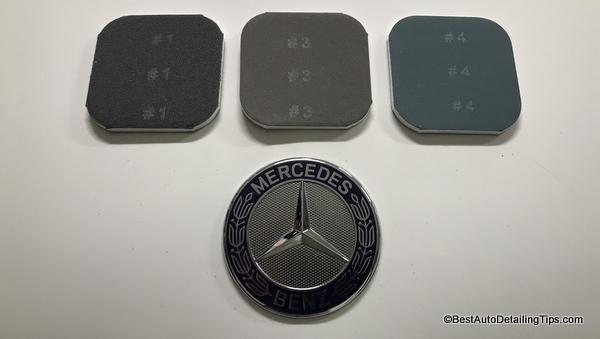
These discs are made using extremely fine levels of sanding abrasives. This means it is safer than traditional wet sending paper that I use as a professional.
The discs are labeled and to be used in order from 1-4 (disc #1 also has disc #2 on the backside)
Once you
have sanded any scratch as per kit instructions, you then use the
Clarifying Compound to buff away the sanding marks which brings back
gloss and depth to the sanded area.
Spray Lubricant: When attempting to sand a chosen scratch for removal, the sanding disc will require the use of the provided spray lubricant.
Simply spray the area you wish to sand and then reapply the spray lubricant as needed to allow the sanding disc to move back and forth across the body panel.
Clear Coat Touch-up Pen: This pen helps bring additional novelty to this clear coat scratch repair kit. You could buy one of these clear coat pens separately, but it also comes with this kit, thus allowing multiple strategies in which to attempt a repair on any of the many types of clear coat scratches you will come across.
While I am not a huge fan of these pens overall, they do have the ability to serve a very specific purpose that cannot be accomplished with the other tools in this kit.
The major problem with these clear coat pens is the inability to control the flow rate of the liquid clear as it comes out.
I also know that many people want to default to using these pens as the route of least resistance, but have unrealistic expectations for these pens which only produces frustration.
Once again - every scratch will prove unique in characteristics - this means you work your way using these steps:
1) Use the Clarifying Compound like you would any other car polish or rubbing compound, as this is the simplest way to begin with. Since some scratches will actually prove to be what is called "transfer" rather than a scratch in your clear coat, you don't want to necessarily start with the sanding discs if this Clarifying Compound proves effective.
I recommend using a micro-fiber cloth, starting with a pea size drop of compound, and rubbing the scratch very vigorously to see if it disappears, or diminishes in appearance.
If this proves inadequate, move onto step 2.
2) Use Spray Lubricant to wet area of scratch, start with disc #1 and work the scratch by sanding it as per instructions. You will sand area with each disc, at which point you will use Clarifying Compound to remove the sanding marks by hand which will restore luster and depth to your clear coat.
At this point you may still have a visible scratch in your clear coat. Once again, not all scratches can be removed or should be. You need to remember that the thickness of your clear coat is limited, and every car will have a different overall thickness to the clear.
If you have sanded the clear coat scratch and used all levels of sanding discs, then this is as aggressive as you will want to get.
3) If you remain dissatisfied with your results, you can sand more going through the same steps as outlined, but you have to accept that you will continue to thin out your clear coat in this area.
That is the trade-off you will weigh in on: no scratch. Or some scratch with as much clear coat thickness as possible.
At this point, you may choose to attempt to apply some clear coat touch-up with the supplied pen. If you mess up this process, you can remove the clear coat touch-up paint using acetone based nail polish remover, or straight acetone.
It is extremely difficult to apply a perfect line of touch-up paint regardless of the color or the car.
Clear Coat Scratch Remover Q. and A.
If you have reached this point of the page, then you are seeking greater understanding which I am always a fan of.
Use the following questions to broaden and deepen your understanding of many things clear coat scratch remover and repair.
Permanent Scratch Removal vs. Concealment
Yes, there is a difference!
In simple terms, concealment would be attempting to fix a clear coat scratch in what many people would call the more traditional method of applying car touch-up paint or clear coat touch-up.
While this can prove to be an effective strategy, it is also what would be labeled as clear coat scratch concealment as you are not actually removing or diminishing the clear coat scratch, but attempting to cover it.
Permanent removal - or diminished - is all about scratching your way to success.
Or at least to "better".
Since not all clear coat scratches can or should be attempted to remove 100%, there are many cases where you are staring at a scratch in your clear coat tat is so deep, removing it 10% would render the clear coat on your paint to the point of losing al levels of integrity because you have thinned it down so much through sanding, compunding, or polishing.
Difference Between Clear Coat and Car Paint
The only real difference is the labeling.
Every car produced since the mid to late eighties will be finished with the top layer being a clear coat.
You can think of clear coat as car paint with no color.
Talking about a car paint scratch is the same as talking about a clear coat scratch. You would not be able to scratch the color coat of your car without first touching the clear coat.
There are extremely few exceptions where a car or truck from the factory has not been finished with a clear coat. In every situation I have come across, this has always been on solid white paint and has always been on trucks.
What Is Clear Coat
The top layer of any factory produce car/truck/van. I emphasize "factory", as a car that has been repainted may in fat not be finished with clear coat.
The only reason any paint and body whop would not finish the paint job with clear coat would be as a cost saving strategy.
Clear coats of today are superior to most any other type of traditional paint you could apply to a car.
What Does Clear Coat Do
It makes your car paint look pretty!
Seriously....
factory paint systems include various layers, and clear coat being the top layer:
- Corrosion inhibitor coating
- Primer
- Color coat - commonly called base coat
- Clear coat
The color coats of modern day, factory paint jobs are dull in appearance and need the clear coat to produce the high level of gloss and depth.
Clear coat paint systems were developed as an answer to meet the increasing demands of air quality regulations.
If you are hearing this for the first time, there may be a part of you that finds this news disappointing. Having taken care of cars for over 30 years I can tell you that clear coat paint systems are truly superior than old school traditional paint systems.
These old school paint jobs are referred to as single stage paint, versus clear coat systems that are referred to as 2-stage paint.
Clear coat also acts as UV protection to the color coat with its ability to filter out much of the harmful UV rays of sunlight.
Clear Coat Scratch Remover Summary
If you have made it this far down the "Rabbit Hole" then you are among the disciplined of society.
Today is a world of "drive-by" learning.
People simply want a headline answer for life's problems. Except life simply doesn't work this way unless of course you have very low standards for yourself.
I will end this page by adding one more important note about clear coat, and clear coat scratch remover:
- Most scratches will prove too deep to be safely removed entirely
- If you can catch a significant edge of the clear coat scratch with your finger nail, it will be safe to assume you will not be able to remove completely
- This industry of detailing and surface paint care is an industry bent on selling you more and more "stuff". Keeping you in the dark as an ignorant car owner is only one of the many strategies of marketing used to separate you from more of your money
- There is such a thing as hard clears and soft clears. This means that the clear coat on your car may require more aggressive use of all these techniques to produce results. Unfortunately there is no definitive way to know, and it really doesn't matter as you will be required to finesse your way to desired results just as any professional detailer is required to do
I hope I have help clarify some of your specific questions, as well as brought light to questions you never thought to ask.
I wish you much success in your clear coat scratch removal efforts!
Sincerely,
Darren Priest
|
|

